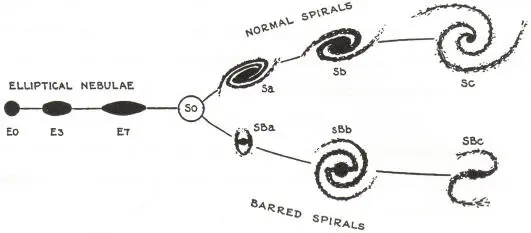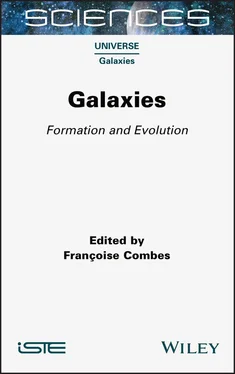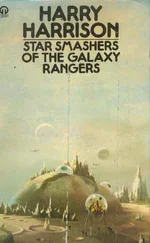Galaxies can be divided into two main categories: disc galaxies or “late-type” and elliptical galaxies or “early-type”. In our Local Universe, the majority of galaxies are disc galaxies and dominate in number, but since elliptical galaxies are more massive, they dominate in mass in the Universe. Early-type galaxies have a spheroidal morphology, and even if they sometimes have a stellar disc, it is subdominant in front of the massive bulge. Their stellar populations are old, and they have little or no gas. For a very long time, astronomers thought that the flattening of stellar spheroids was due to rotation, but when it became possible to measure their velocities, it was realized that the shapes of these spheroids were instead due to the anisotropy of the velocity dispersion: ellipticals have no or very little rotation. It is then difficult to deproject these systems, which can be triaxial. They are classified as slow or fast rotators. The origin of these differences comes from their history of formation by merger of spiral galaxies.
Late-type disc galaxies are also called spiral galaxies. Their structure of open spiral arms has long been a mystery, because the differential rotation of the disc should wind up the arms around very quickly, making them disappear. But they are actually density waves and not material arms. The arms are quite transient and several waves follow one another; on the other hand, the bars are more robust structures, which allow the galaxy to assemble its mass and evacuate the angular momentum of the accreted gas. The speed of the bar wave can be determined by the different resonances in the plane (forming rings) and perpendicular (forming peanuts or boxes). The discs of the spirals evolve essentially in a secular way, but from time to time an interaction or merger with another galaxy can increase the mass of the bulge and the mass concentration. Star formation is enriched by the accretion of gas from the cosmic filaments, which keeps the galaxy blue and active. On the other hand, the environment of a group or cluster of galaxies can dry up the gas reservoir and stop star formation. The galaxy then becomes red and passive. Among the millions of known galaxies, a clear bimodality has been observed between the red sequence and the blue cloud.
Interactions between galaxies contribute to the enrichment of galaxies with gas, which can create a starburst. Interactions are visible even at large distances because of tidal arms and morphological perturbations of galaxies. Of course, these effects are all the more visible in groups and clusters of galaxies. In the latter, galaxies are swept away from their gas by the ram pressure. Looking back in time, we can see that the number of interacting galaxies was greater in the past, in the first part of the age of the Universe. This could explain part of the history of cosmic star formation.
In today’s galaxy clusters, we observe a morphological segregation: the spirals that dominate in number in the rest of the Universe are gradually disappearing to make way for lenticulars and ellipticals. Galaxies in clusters no longer form many stars. But this was not the case in the past. Already the first observers of distant clusters had noticed blue galaxies, the so-called Butcher-Oemler effect. There must even have been a time in the Universe, at the time of cluster formation, when interactions between galaxies make clusters or proto-clusters richer in star formation than elsewhere in the field. The evolution of galaxies and the history of their star formation have made a lot of progress in recent years, due in particular to several infrared satellites, which have revealed galaxies obscured by dust, where star formation is hidden in the visible, but emerges only in the infrared radiation of dust heated by young stars. The spectral distribution of the radiation from galaxies also makes it possible to distinguish the amount of star formation, and to separate the heating that is due to the energy of super-massive black holes from that due to the energy of stars. The efficiency of star formation varies over time, due to the fraction of gas in galaxies, which was much larger in the past, and to the feedback phenomena of active nuclei, corresponding to the rapid growth of black holes.
The enormous progress made in our knowledge of galaxies should not make us forget all that remains to be discovered, especially since most of the mass of a galaxy is made of exotic dark matter, the nature of which we do not know!
1
The Classification of Galaxies
Ronald BUTA
Astrophysics, University of Alabama, Tuscaloosa, USA
The classification of the forms of galaxies in a well-defined visual system is a critical step in the study of galaxies as physical objects. The Comprehensive de Vaucouleurs revised Hubble-Sandage (CVRHS) system is currently the most detailed approach that can be applied effectively to more than 95% of all galaxies. This chapter describes the different types of galaxies and the factors that may determine various morphological features.
Galaxies are complex gravitational systems whose structure has been influenced not only by how they formed but also by the environment into which they were born. A century ago, getting a classifiable image of a single galaxy was a major effort involving long exposures of photograph plates. Today, there are classifiable images of literally millions of galaxies available through the Internet. Although it is not obvious how any galaxy arrived at its current morphological state, examination of the details of large numbers of galaxies have led to important physical insights into the roles played by both internal and external processes. It is for this reason that classical galaxy morphology and classification have survived into the modern era.
Galaxy morphology and classification began with simple descriptive terms for angular size, brightness and central concentration based on visual observations (e.g. Dreyer 1888). Although large 19th-Century reflectors did reveal through visual observation some genuine aspects of galaxy morphology, it was photography that led to the classification systems of the early-to-mid 20th Century, including those of Wolf (1908), Reynolds (1920), Hubble (1926, 1936), Lundmark (1926) and Morgan (1958). On the plates of the time, which were relatively more sensitive to blue light than to red light, details of spiral arms, disks and bulges could be used as classification criteria. In spite of great observational and theoretical progress in extragalactic studies during the past century, modern galaxy classification is still basically tied to the system proposed by Hubble (1936; Figure 1.1), only now the system is applied using digital images rather than photographic plates. The main reason the Hubble system has survived for nearly a century is that the aspects Hubble focused on (degree of central concentration, pitch angle and resolution of spiral arms, amount of distinct structure) correlated with measured properties of galaxies, such as luminosities, colors, stellar populations, HI content and global star formation history. This gave his view an astrophysically relevant edge that has driven much of extragalactic research since his time.

Figure 1.1. The Hubble (1936) “tuning fork” representation of galaxy morphology
This chapter describes the different classes of galaxies within the framework of the “Comprehensive de Vaucouleurs revised Hubble–Sandage” (CVRHS) classification system, a visual system that follows the precepts of de Vaucouleurs (1959), who proposed a personal revision of the Hubble–Sandage (HS) classification (Sandage 1961; Figure 1.2) that he believed provided a better description of galaxies without being too unwieldy. For many galaxies, the CVRHS classification is no more complicated than a de Vaucouleurs (1959) VRHS classification. However, the system has been designed to take into account more details that are of astrophysical interest today and which have become more noticeable and relevant in the era of digital astronomical imaging. These details include lenses, nuclear rings and bars, ansae bars, boxy/peanut bulges, boxy and disky elliptical galaxies, special outer rings and pseudorings, dust lanes and galactic disk warps.
Читать дальше













